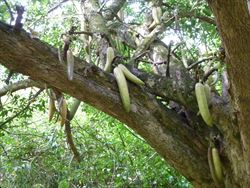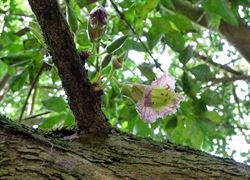Click on images to enlarge

Photo by Wendy Cutler - flickr.com (CC BY-SA 2.0)

Photo by Wendy Cutler - flickr.com (CC BY-SA 2.0)
Scientific Name
Parmentiera aculeata (Kunth) Seem.
Synonyms
Parmentiera edulis DC.
Family
Bignoniaceae
Common Names
cuachilote, cuajilote, cucumber tree, guajilote
Origin
This species is native to Mexico and Central America (i.e. Belize, El Salvador, Guatemala and Honduras).
Cultivation
This species is occasionally cultivated in tropical regions as an ornamental or grown for its edible fruit.
Naturalised Distribution
Cucumber tree (Parmentiera aculeata) is currently only locally naturalised in far northern Queensland. It is largely found in the catchments of the Barron and Mulgrave Rivers, both within the boundaries of the Cairns City Council.
Habitat
Cucumber tree (Parmentiera aculeata) has invaded rainforests and riparian areas in some catchments in tropical Far North Queensland.
Habit
A small to relatively large upright (i.e. erect) tree usually less than 6 m tall, but occasionally growing up to 12 m in height.
Distinguishing Features
- a thorny tree with branches that have a pair of short stout spines at each joint.
- its oppositely arranged compound leaves each have three leaflets.
- its trumpet-shaped flowers (5-6.5 cm long) are greenish with brownish-purple lines in the throat.
- these flowers are borne in the leaf forks and also along the older branches.
- its yellowish-green fruit is ridged and cucumber-like in appearance (11-17 cm long and more than 3 cm wide).
Stems and Leaves
The older stems are pale brown in colour and covered with relatively smooth bark. A pair of stout curved spines (up to 15 mm long) are usually located on the branches near each joint (i.e. node). The younger branches are green, rounded (i.e. terete), and hairless (i.e. glabrous).
The oppositely arranged leaves (4-8 cm long) are compound with three leaflets (i.e. they are trifoliate) and are borne on grooved stalks (i.e. petioles) 13-35 mm long. The somewhat oval-shaped (i.e. elliptic-obovate) leaflets have entire margins and may have either rounded or pointed tips (i.e. obtuse or acute apices). The two side (i.e. lateral) leaflets on each leaf are usually slightly smaller (2-5 cm long) than the end (i.e. terminal) leaflet (3.5-5 cm long).
Flowers and Fruit
The green or greenish-white flowers (5-6.5 cm long and with a mouth 2-2.5 cm wide) are trumpet-shaped (i.e. tubular) and usually have some brownish-purple coloured lines in their throats. Each flower has five green sepals, that are fused into a tube (i.e. calyx tube) about 3 cm long, and five greenish or whitish petals that are also fused into a tube (i.e. corolla tube) for most of their length. These flowers can be located in the leaf forks (i.e. axils), along the branches, and even on the main trunk. They may be borne singly or in few-flowered clusters.
The cucumber-like fruit (11-17 cm long and more than 3 cm wide) is ribbed (i.e. costate) and turns yellowish-green in colour as it matures. These fruit are usually also slightly curved.
Reproduction and Dispersal
This species reproduces by seed. The seed are dispersed by water and also by birds (e.g. cockatoos) that take the fruit and eat it elsewhere.
Environmental Impact
Cucumber tree (Parmentiera aculeata) is regarded as an environmental weed in northern Queensland. It has invaded rainforest and riparian areas in the Barron and Mulgrave catchments in tropical far northern Queensland, where it out-competes and/or replaces native trees.
While this species currently has a relatively limited distribution, and has not yet necessarily caused serious ecological damage, it is thought to pose a major threat because it can form dense monospecific stands displacing native species. It has demonstrated a high measure of invasiveness in relatively intact forest systems of the Wet Tropics bioregion and was recently ranked among 12 species judged to pose the most serious threats to the environmental integrity of this region. Because of this, cucumber tree (Parmentiera aculeata ) is listed as a Category 1 species in the Far North Queensland Priority Weed List and has been targeted for eradication in this region.
Legislation
Not declared or considered noxious by any state government authorities.
Similar Species
Cucumber tree (Parmentiera aculeata) is very similar to candle tree (Parmentiera cereifera), which is occasionally cultivated in gardens in northern Australia. These two species can be distinguished by the following differences:
- cucumber tree (Parmentiera aculeata) has a pair of spines at each joint on its branches. Its relatively thick cucumber-shaped fruit (11-17 cm long and more than 3 cm wide) are ribbed and usually slightly curved.
- candle tree (Parmentiera cereifera) does not have any spines on its branches. Its very elongated candle-shaped fruit (30-55 cm long and 1-2.5 cm wide) are smooth and relatively straight.

